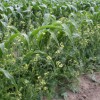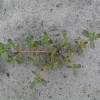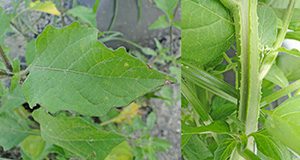This three-page fact sheet describes the biology and management of American black nightshade, explaining how to control for it in tomato and pepper, cucurbits, and strawberry. Written by Nathan S. Boyd, Shawn Steed, Chris Marble, and Andrew MacRae and published by the Horticultural Sciences Department.
http://edis.ifas.ufl.edu/hs1176
Tag: Vegetable Weeds
Weed Management Principles in Commercial Vegetable Production
 Weeds compete with vegetable crops for light, water, and nutrients. This competition decreases plant vigor, yield, and crop quality. They interfere with hand harvest and can complicate or prevent machine harvest. Weeds also serve as alternative hosts to diseases, viruses, and nematodes. A successful weed management program will incorporate multiple control practices with preventative, cultural, biological, mechanical, and chemical methods.
Weeds compete with vegetable crops for light, water, and nutrients. This competition decreases plant vigor, yield, and crop quality. They interfere with hand harvest and can complicate or prevent machine harvest. Weeds also serve as alternative hosts to diseases, viruses, and nematodes. A successful weed management program will incorporate multiple control practices with preventative, cultural, biological, mechanical, and chemical methods.
This 6-page fact sheet was written by Peter Dittmar and Nathan Boyd, and published by the UF Department of Horticultural Sciences, July 2014.
http://edis.ifas.ufl.edu/cv113
Biology and Management of Common Purslane in Fruiting Vegetables, Cucurbits, and Strawberries
 Purslane occurs throughout the year in Florida. It produces thousands of seeds per plant, which germinate readily, but can also persist in the soil for up to 15 years. Vegetative shoot fragments can survive on the soil surface for extended periods of time, then re-root when exposed to moisture and can even flower and produce seeds after they have been pulled from the soil. This characteristic enables purslane to persist and spread following cultivation. This 4-page fact sheet was written by Nathan S. Boyd, Andrew W. MacRae, Rick Kelly, and Ixchel M. Hernandez, and published by the UF Department of Horticultural Sciences, July 2014.
Purslane occurs throughout the year in Florida. It produces thousands of seeds per plant, which germinate readily, but can also persist in the soil for up to 15 years. Vegetative shoot fragments can survive on the soil surface for extended periods of time, then re-root when exposed to moisture and can even flower and produce seeds after they have been pulled from the soil. This characteristic enables purslane to persist and spread following cultivation. This 4-page fact sheet was written by Nathan S. Boyd, Andrew W. MacRae, Rick Kelly, and Ixchel M. Hernandez, and published by the UF Department of Horticultural Sciences, July 2014.
http://edis.ifas.ufl.edu/hs1238
HS1173 Common Purslane Biology and Control in Fruiting Vegetables, Cucurbits, and Small Fruits
HS1173, a 3-page illustrated fact sheet by Andrew W. MacRae, describes this drought resistant annual with succulent leaves found in most habitats in Florida — classification, seedling identification, mature plant, management considerations, and chemical control. Includes references. Published by the UF Department of Horticultural Sciences, May 2010.
http://edis.ifas.ufl.edu/hs1173
HS1172 Florida Pusley Biology and Control in Fruiting Vegetables, Cucurbits, and Small Fruits
HS1172, a 3-page illustrated fact sheet by Andrew W. MacRae, describes this drought-resistant annual with hairy leaves and stems that is common in row middles, strawberry production fields, and organic mulch for highbush blueberries — classification, seedling identification, mature plant, management considerations, and classical control. Includes reference. Published by the UF Department of Horticultural Sciences, May 2010.
http://edis.ifas.ufl.edu/hs1172
HS1176 American Black Nightshade Biology and Control in Fruiting Vegetables, Cucurbits, and Small Fruits
HS1176, a 3-page illustrated fact sheet by Andrew W. MacRae, describes this weed common in fruting vegetable fields, cucurbit, and strawberry production — classification, seedling identification, mature plant, management considerations, and chemical control. Includes reference. Published by the UF Department of Horticultural Sciences, May 2010.
http://edis.ifas.ufl.edu/hs1176
HS1178 Goosegrass Biology and Control in Fruiting Vegetables, Cucurbits, and Small Fruits
HS1178, a 2-page illustrated fact sheet by Andrew W. MacRae, describes this large grass common in mulched row crops and blueberry production fields — classification, seedling identification, mature plant, management considerations, and chemical control. Includes references. Published by the UF Department of Horticultural Sciences, May 2010.
http://edis.ifas.ufl.edu/hs1178
